Our Summer Cruise 2016
May 16 - 22 |
May 23 - 29 |
May 30 - Jun 5 |
Jun 6 - 12 |
Jun 13 - 19 |
Jun 20 - 26 |
Jun 27 - Jul 3 |
Jul 4 - 10 |
Jul 11 -17 |
Jul 18 - 24 |
Jul 25 - 31 |
Aug 1 - 7 |
Aug 8 - 14 |
Aug 15 -21 |
Aug 22 - 28 |
Aug 29 - Sep 4 |
Sep 5 - 11 |
Sep 12 - 18 |
Sep 19 - 25 |
Monday, July 25
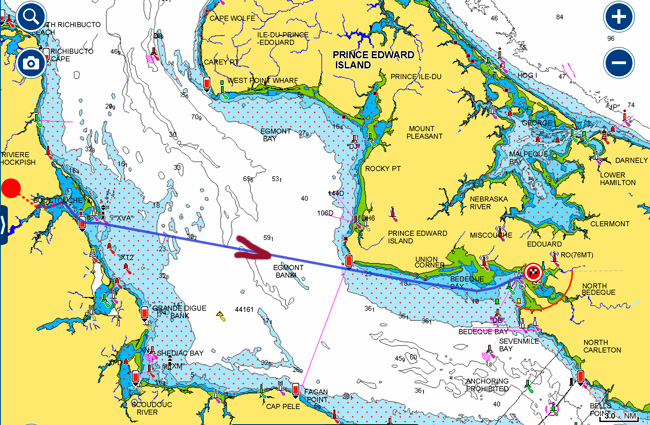
Bouctouche, NB to Summerside, Prince Edward Island - 43nm
Very foggy morning as the rest of the gang took off early for Summerside, while we spent a few hours doing a little more sightseeing in Bouctouche. First on our list, was a bike ride around the Jean E.S. Irving Plantation just across from the Marina. For the past 35 years, Mrs. Irving has designed, supervised and planted over 5000 trees and shrubs native to Zones 4 through 7 covering over 100 acres surrounded by dry-stacked stone walls built by builders from Wales and Scotland.
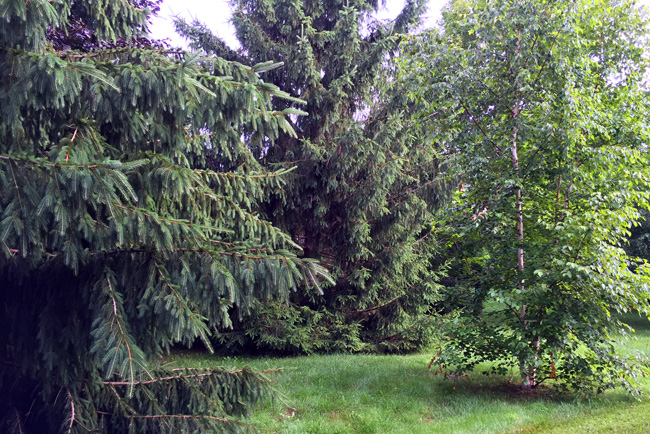
From there we continued around the Elizabethan Garden; over 20 acres of about 9000 perennials and over 3000 shrubs, all immaculately maintained in manicured lawns. The gardens were at their peaks and a mass of color and textures.
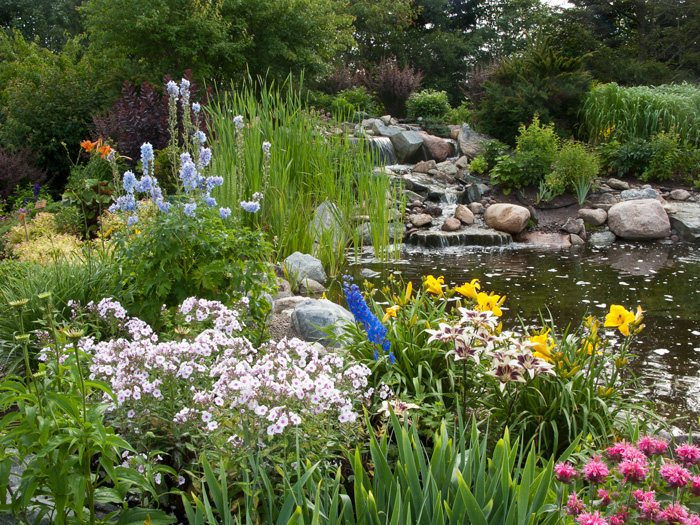
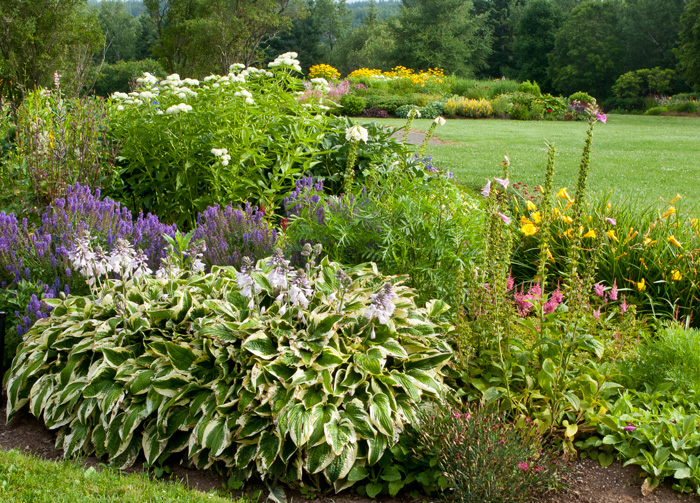
Within the grounds of the Irving Plantation was our next stop - the Irving Memorial Chapel. Inspired by their Scottish heritage and small kirks they had seen in Scotland, Mr. and Mrs. J.K. Irving decided to build a small chapel and they did it right, hiring the best architect, carpenters, stonemasons, blacksmiths, and glass artists, (many from the local communities) and using the pick of materials from Douglas Fir, white oak, cherry, slate and local stone. Completed in 2005, the nondenominational chapel holds services every week, usually attended by many members of the Irving family, and is full to capacity.
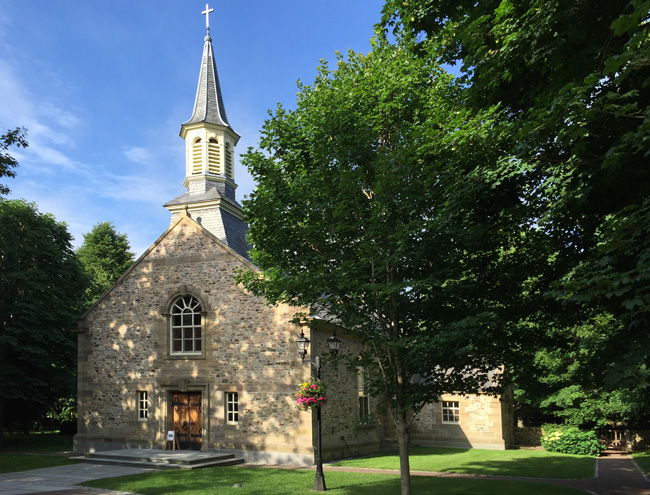
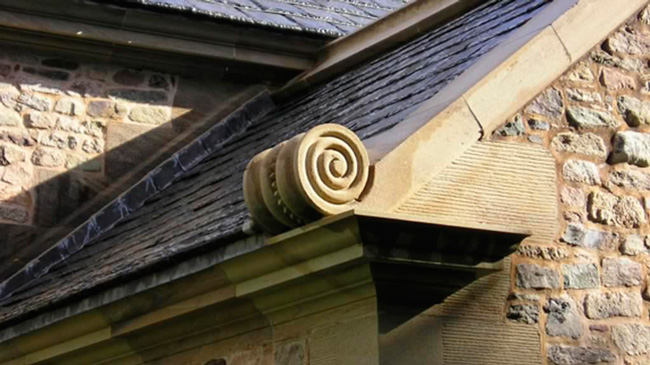
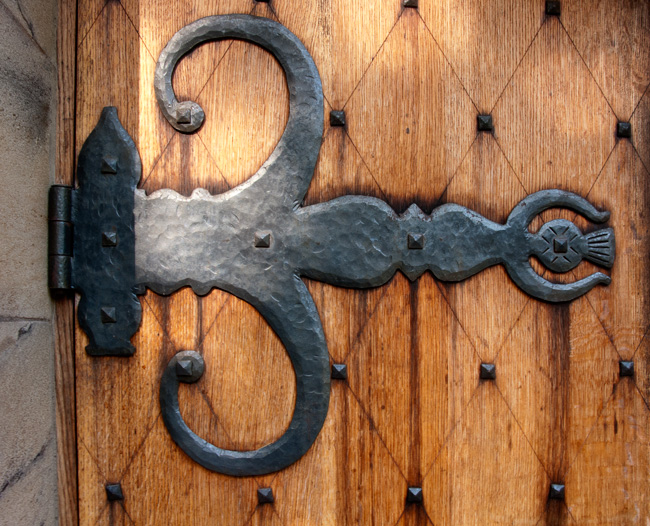
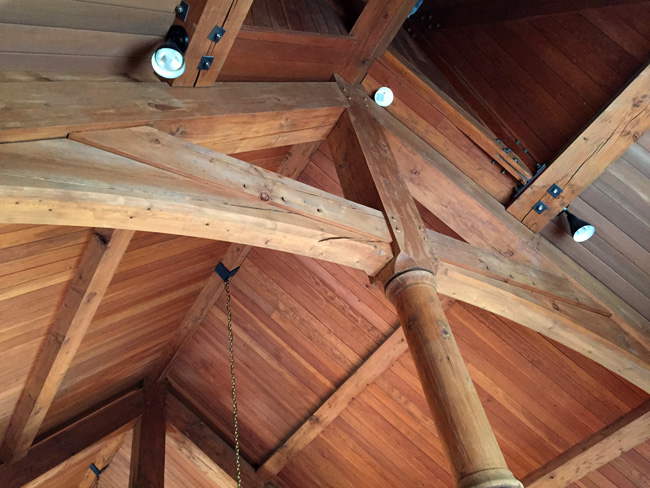
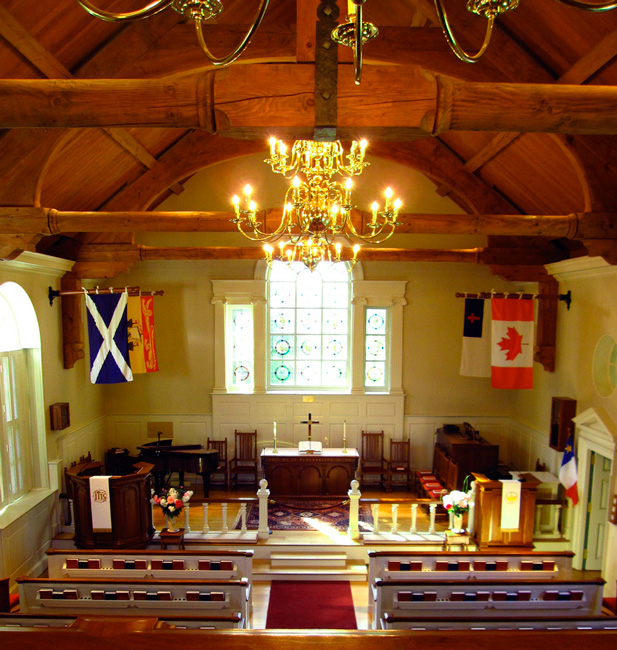
We spent almost an hour talking with Gloria, an Irving employee who is the resident guide, learning about the history of the chapel and the Irving family.
Kenneth Colin Irving, (March 14, 1899 – December 13, 1992) also known as K. C. Irving was one of Canada's foremost entrepreneurs of the 20th century and ranked as one of the world's leading industrialists. K. C. Irving's business began in the family sawmill in Bouctouche, N.B., in 1882. Ownership and operation of the Irving group of companies ultimately divided among his three sons and their respective children, James, the oldest brother and his (James') two sons, Jim and Robert, took more control of forest products and several other divisions, Arthur the middle brother assumed more autonomy in Irving Oil, which owns the Saint John, New Brunswick Irving Oil Refinery, Canada's largest refinery, and Jack who looked after much of the construction, engineering and radio & television stations.
According to Fortune Magazine in September 1989, at the age of 90, K.C. Irving was the 11th wealthiest man in the world with an estimated fortune of $10 billion. Today, Forbes ranks the Irving family as the third wealthiest in Canada. Bouctouche and nearby Reston, still have a great importance in the lives of the Irvings and it clearly shows in the efforts they have made to support the community with a number of projects such as the Sawmill Point Marina where we are staying and the Irving Eco-Center: La dune de Bouctouche to preserve and restore one of North Americas great sand dunes.
The fog had not lifted by the time we left; the buoyage going out twisted through a narrow channel but radar and "eagle eyes" picked up the buoys. By the time we reached open water, the fog had cleared.
By the way, I should have mentioned in last week's blog about the Sawmill Point Marina. We cannot say too much about it - excellent place to stay and the hospitality of John, the marina manager, was outstanding!!
Not much to say about the run as it was very calm the entire way and we missed the fog and waves that the others ran into across the Northumberland Strait having some good views as we paralleled the shore before turning into the bay enclosing Summerside. As we were approaching, the marina some nearby kayakers shouted to us that there was a PWC in trouble further East of us so we did the right things and threaded our way about 3/4 mile through some skinny water to them. They had sucked something into their drive and were immobilized. Hooked up a tow rope and slowly took off when they shouted that they didn't want that to go that way! His girlfriend on the back made him see sense as he was untying the tow rope and we headed to the public wharf to drop them off. By the wharf, again, the stupid guy wanted to go somewhere else so he didn't have to walk as far to the ramp to get his trailer. If it had been his towline, it would have been cut; unfortunately it was mine!
We docked at the Summerside Yacht Club, a very friendly and informal little marina right in town. After a quick rinse of the boat to clean the salt off, I headed to Staples where, hopefully, my new Macbook charger was awaiting me; they eventually found it and I was set to go again.
We had tickets for the Highland Storm, a concert at the College of Piping and Celtic Performing Arts in town for later in the evening (just a short walk from the Marina) where we enjoyed a couple of hours of Scottish highland dancing, step dancing, piping, and drumming. The performers were either faculty at the College or senior students; all very talented!
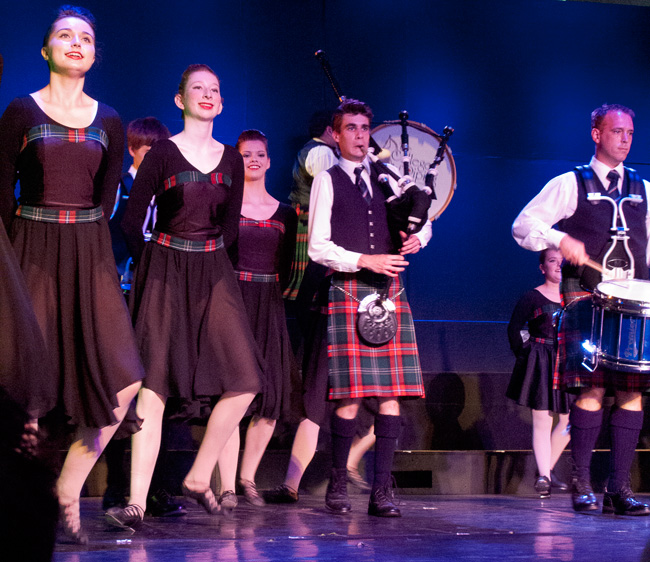
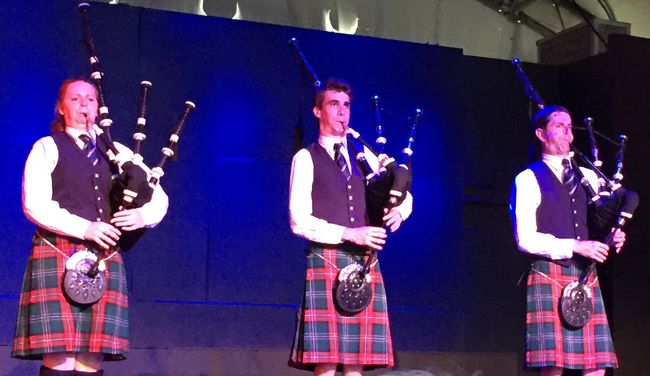

Teacher and Student
Tuesday, July 26
Up early to walk a ways to get the rental car we had reserved earlier and were almost out of luck as the online rental agency, ACE, does not do a good job coordinating with the local company's inventory. Unfortunately we got a fully loaded Chrysler Minivan for the price of a subcompact. Luxurious, with wide side windows for the wives, but a bit heavier on gas.
Prince Edward Island (PEI) has three sign posted driving routes covering different parts of PEI and today we chose to do the North Cape Route counterclockwise with Stephen and Fran.
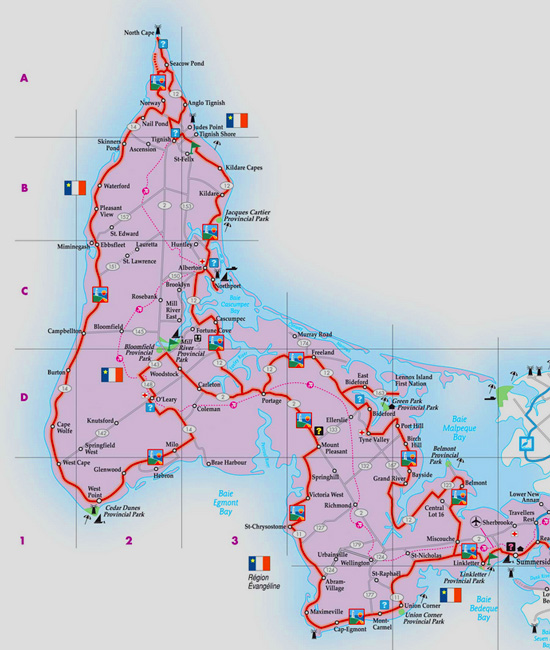
The 350 km North Cape Coastal Drive
As we headed out of Summerside it wasn't too long and we had our first stop along a straight stretch of road with not much around; at the Eglise-Notre-Dame-Du-Mont Carmel, a small Acadian community of less than 1,000.
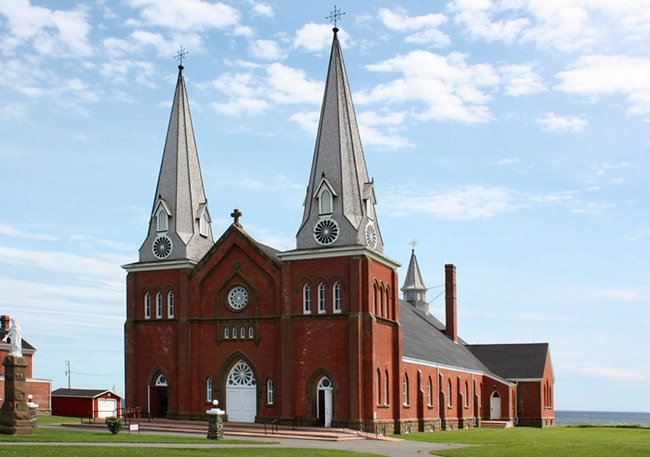
Construction was begun in 1888, when the Parish priest promised the parishioners a cathedral. With only six thousand dollars in the bank, construction of the massive brick church was completed enough by the end of 1989 to hold the first Mass. Truly a community effort, over 450,000 bricks were made locally by volunteers, local bricklayers worked in their spare time, and local carpenters finished the interior over the years. Finally in 1928, a team of Master Painters from Italy painted the interior concrete columns, using "secret" techniques while locked in the Church, to resemble marble, onyx and other stones. They did a fantastic job and the columns are still in excellent condition today. The church cost $75,000 to build and was paid off in less than 30 years. Not satisfied with just the church, the community also built a Rectory alongside the Church "fit for an Archbishop".
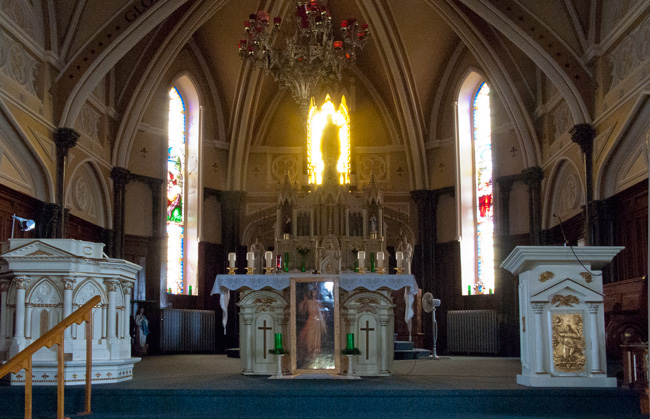
PEI has three main sources of income, tourism, fishing and potatoes. On this part of the island drive we encountered all aspects:

Potatoes
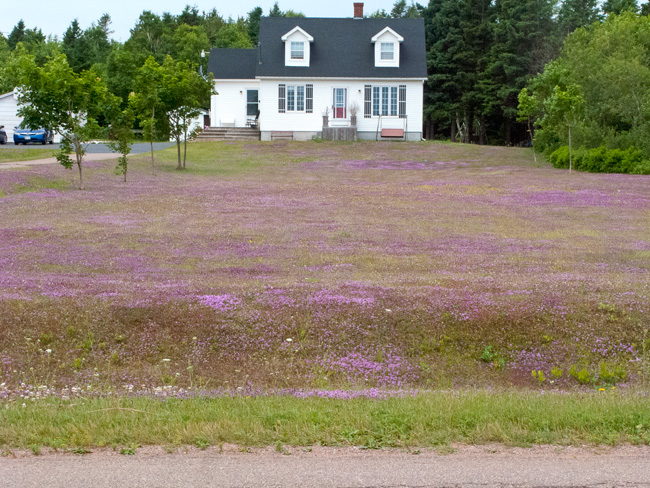
Clover Lawns Everywhere
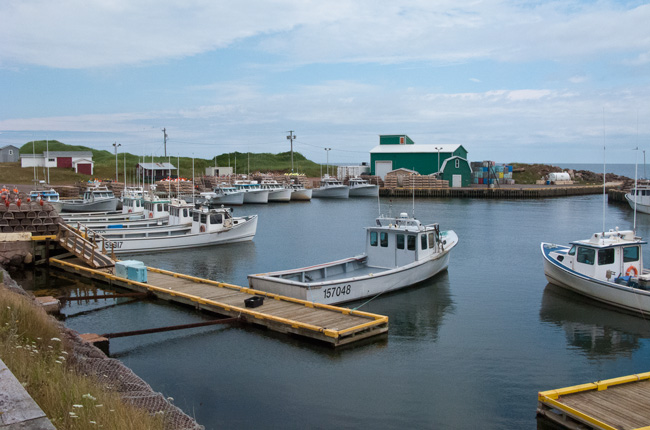
Very Neat Harbors
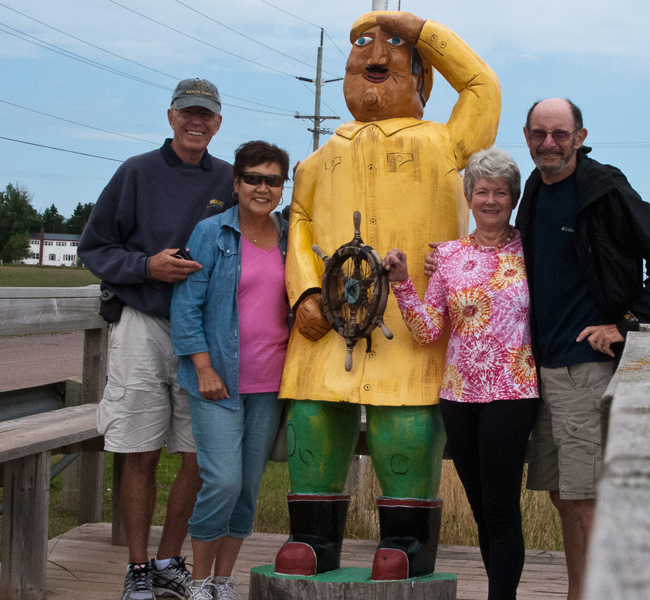
The Tourist Photo Op
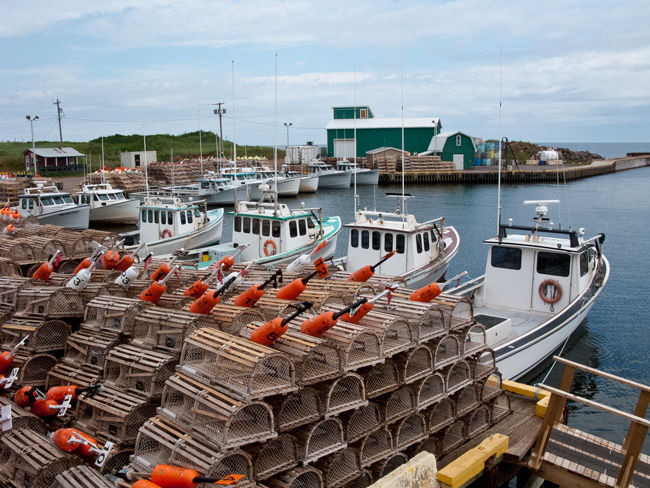
Lobster Season is Done
The lobster season is done but they still had fresh cod, haddock, salmon, and halibut so we bought a load of fish that will last us a couple of weeks.
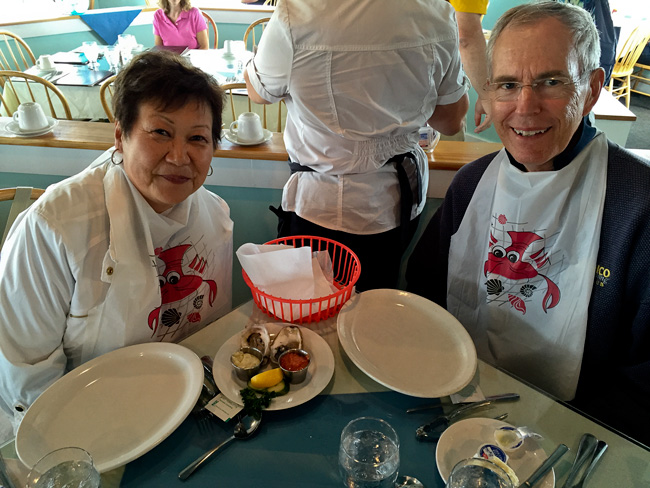
Fran And Stephen Waiting in Anticipation at the North Cape Restaurant
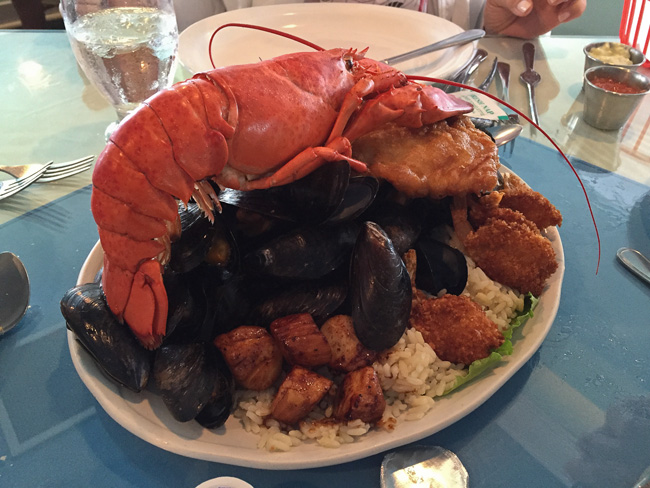
The Mega-Seafood Platter Shared by Stephen and Fran
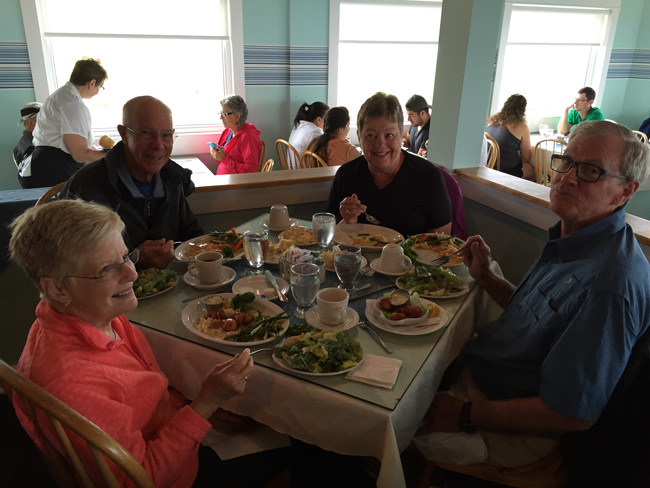
Who Should Turn Up But Barb, Lee, Jan, and Bob!
At the North Cape, there is a large Windmill Farm and Interpretation Center. The Farm was an experimental center for many years due to the strong winds in the area and had everything from small backyard size windmills to the latest large-scale.
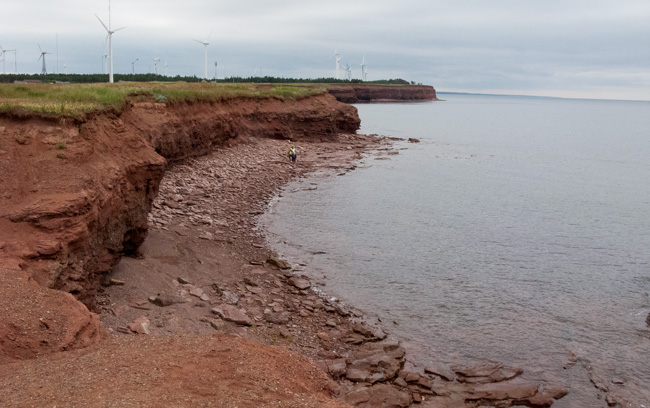
As Far North As You Can Go On PEI - Earth is Very Red in PEI
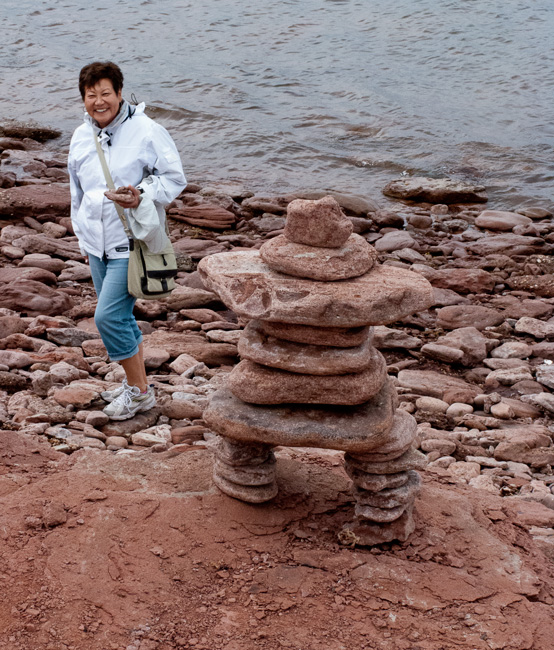
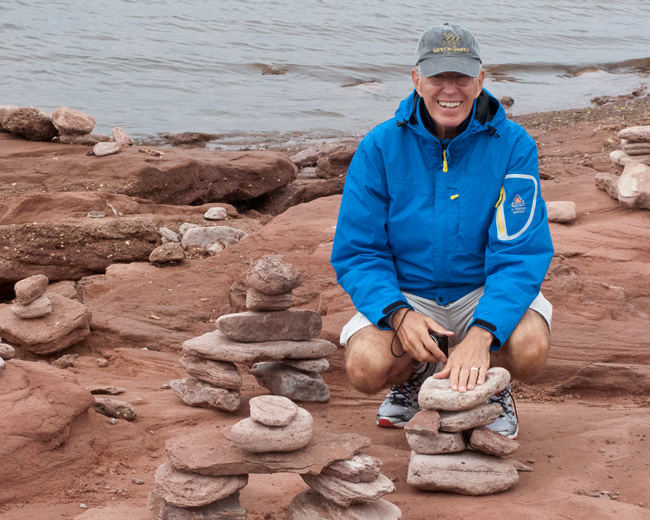
Stephen Building His Own Inukshuk
Many miles to go, we moved on with a number of detours off the route for bridge replacement until we reached a small harbor so checked it out and found a small restaurant/bar.
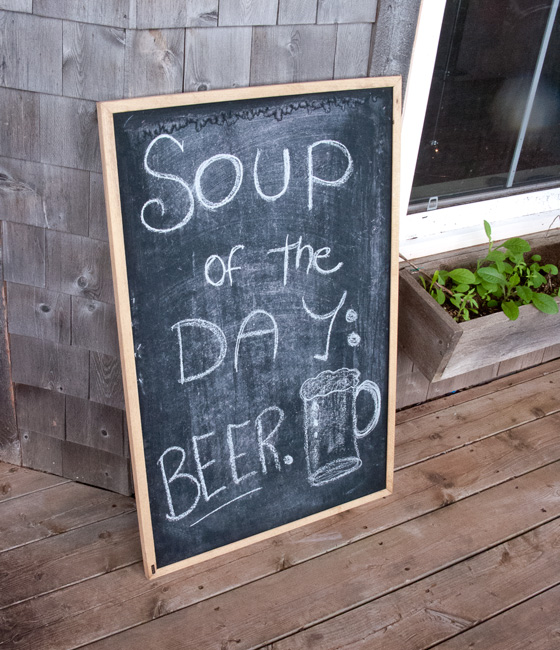
Emphasis on Beer!
Here they had some unique mixed beer drinks and, of course, Judy wanted one they didn't have - with a dark beer so they agreed to mix one at her own risk and it did taste pretty good. They may add it to the menu as "The Other One".
The scenery on the latter part of the drive was quite rural with less farming but all the farms had a lobster boat parked by the barn with lobster and crab pots stocked alongside. We figured that the typical farmer's schedule must be when potato planting is done, it's time for lobster season, then mackerel season for bait for next year, then pull the boat, harvest the potatoes, and then go to Florida or Arizona for the winter. If you don't go to Florida or Arizona then you cut and split a huge stack of wood like this as it gets very bleak here.
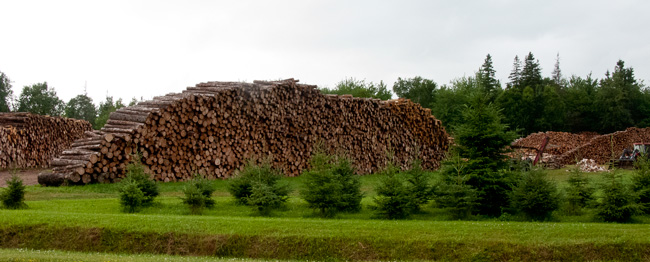
The last place on our tour was Miscouche, a small Acadian town that looked very attractive with its impressive church in the center and an Acadian Museum. Unfortunately, time was short and we just had to look as we went by.
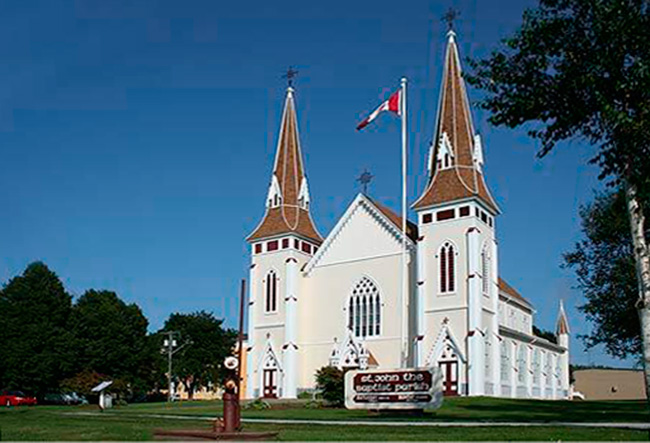
St. John the Baptist Church, Miscouch
Arrived back at the boat around 7:00 to find (or not find) that Fran didn't have her purse. Calling back to the bar, they had found it. I drove with Stephen about 60 miles each way but we recovered Fran's purse. I knew I should have put Stephen on the car as an additional driver!
Wednesday, July 27
Today, the four of us decided to take the Central Coast Route clockwise, slightly shorter than yesterday, as we had to return the car by 5:00pm. Looping the province’s central region, the 253 kilometer drive highlights two distinct shores. The southern Red Sands Shore portion of the Drive runs along Northumberland Strait, where sandstone cliffs and gentle beaches are the rich Island-red shade that contrasts perfectly with green pastures. Gateway Village at the foot of the Confederation Bridge, Victoria-by-the-Sea and Port-La-Joye–Fort Amherst National Historic Site are highlights in Red Sands Shore. Some of the Island’s most picturesque sea views are found in Green Gables Shore, along the northern portion of the Central Coastal Drive, the home of Anne of Green Gables.


We hadn't gone too far when, surprise, we came across our first church of the day, St Mary's in Indian River, again built largely by volunteer labor. The Church, the largest in PEI, was recently deconsecrated and now is owned by the Indian River Festival organization for events and is slowly being restored.
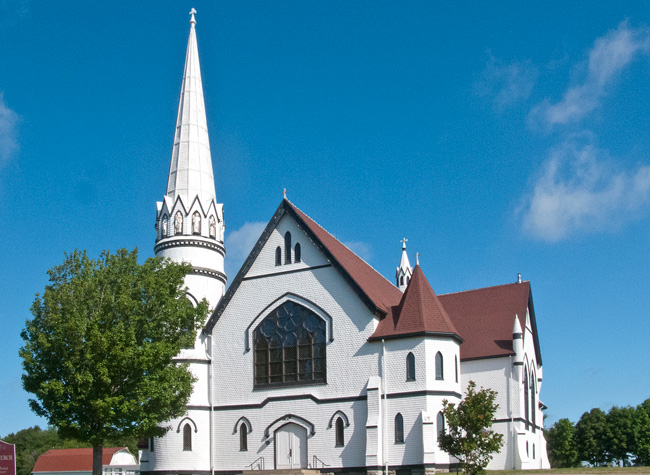
This Route is noted for its scenic value and we certainly saw much of it under a beautiful sky.
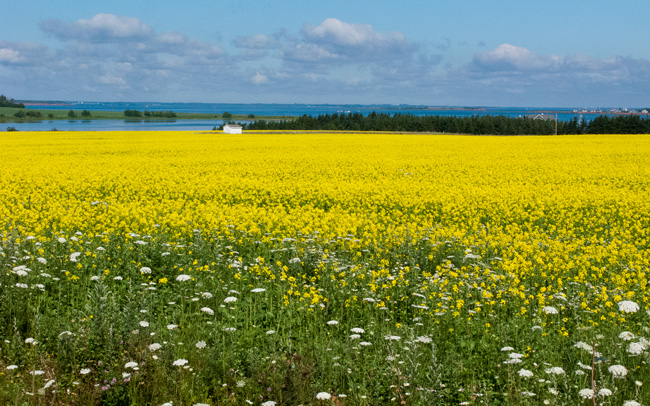
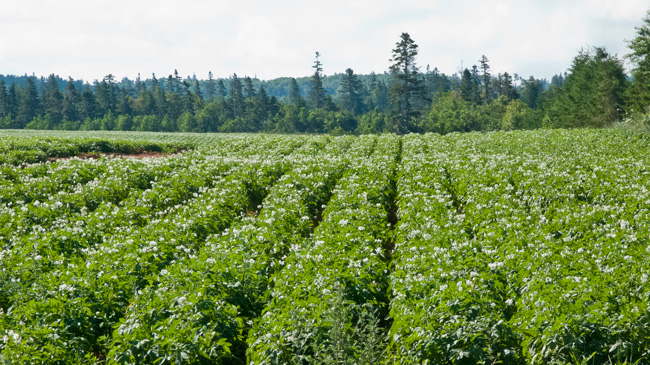
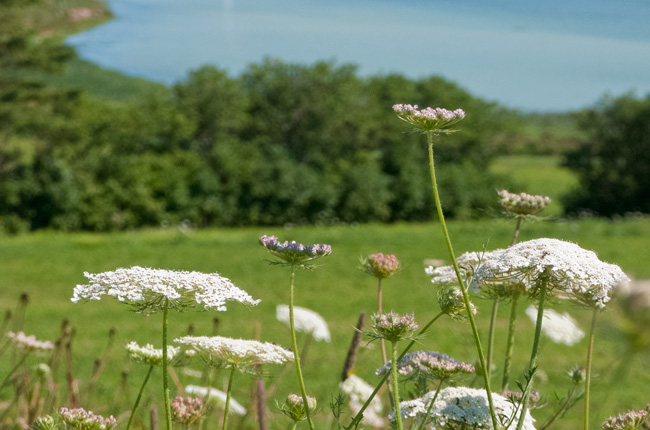
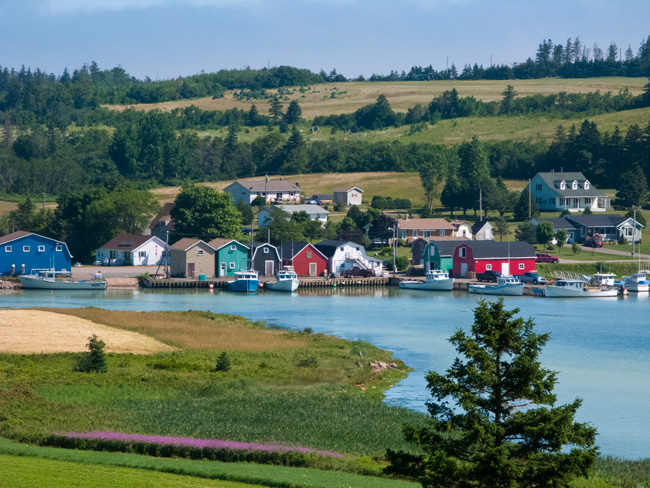
At the small fishing harbor above, we found a small seafood shop and ended up with at least another four dinners of fresh cod, haddock and salmon, caught last night - it doesn't get any better!
Lunch was on the schedule and we stopped at the Preserve Factory, a restaurant and preserve (jam) maker, where we had an ad hoc mix of tea, scones, and great nachos before stocking up on some unusual berry preserves and salsa. Of course we had to do the tourist thing as well - we are TOURISTS!
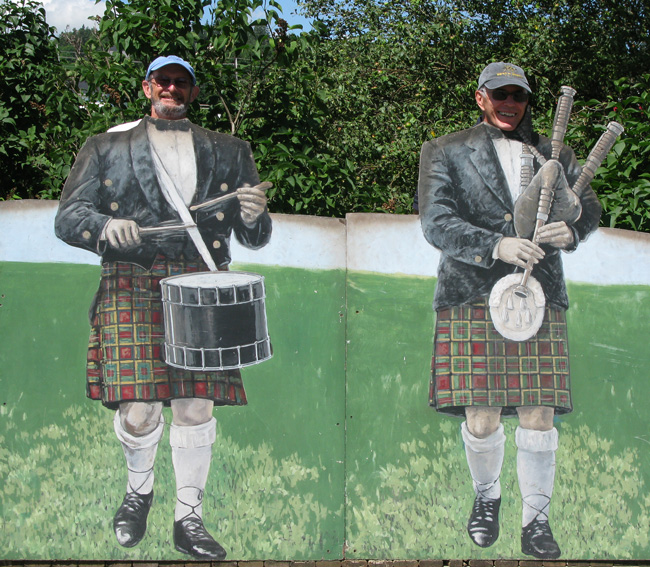
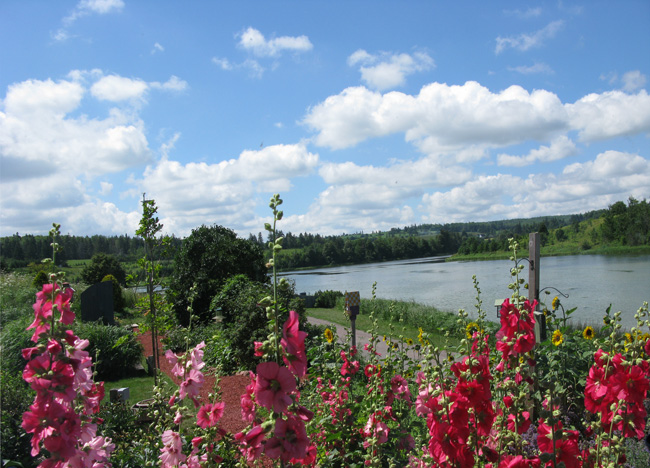
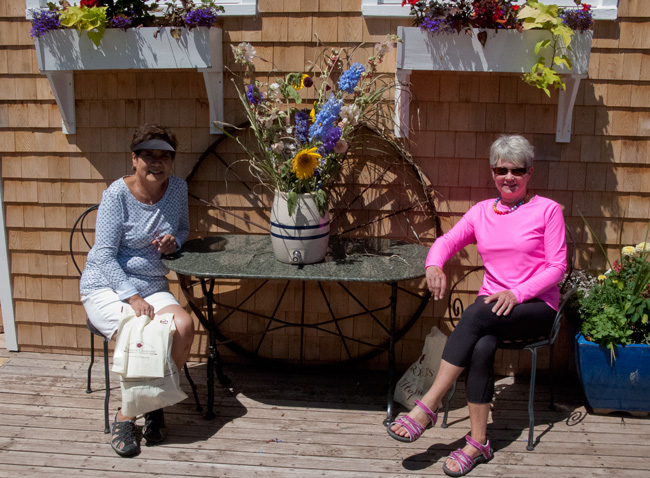
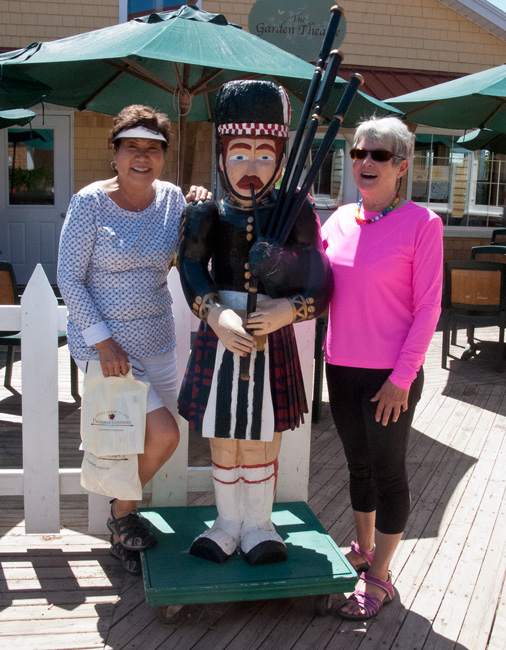
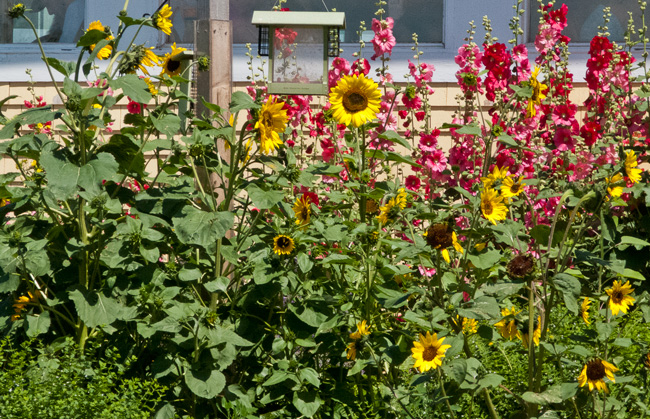
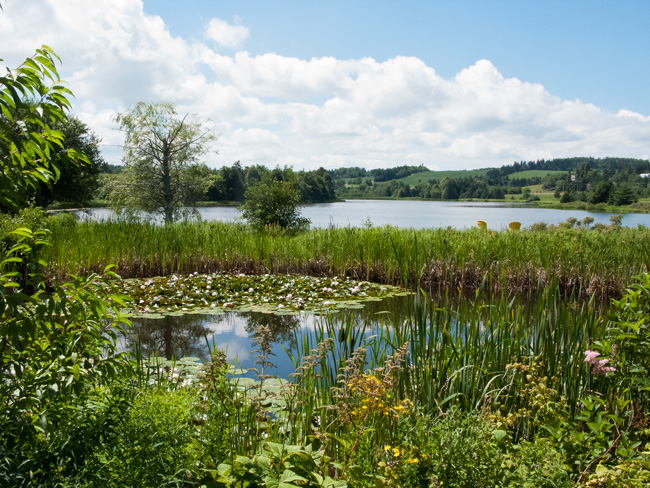
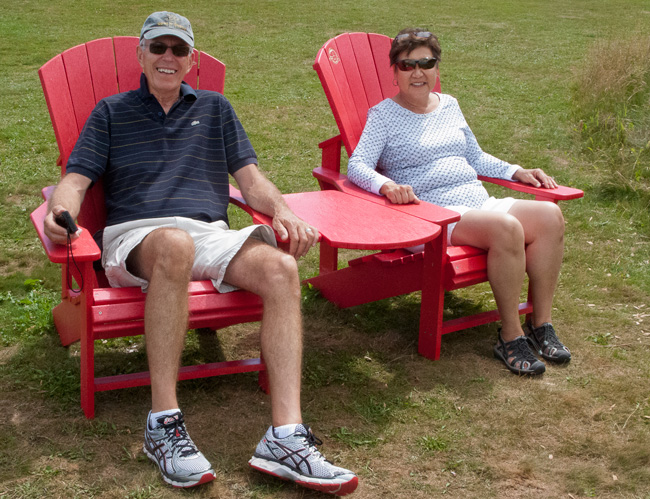
Parks Canada has a program where they place two red Achromatocyte chairs overlooking a scenic view at their locations. We first noticed them this year in Georgian Bay and have seen a number since.
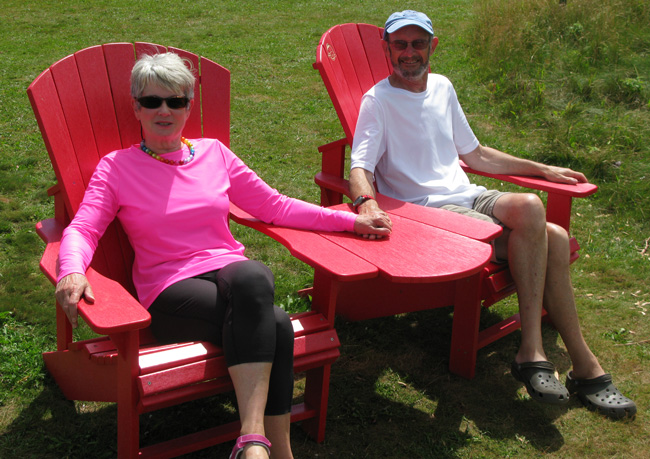
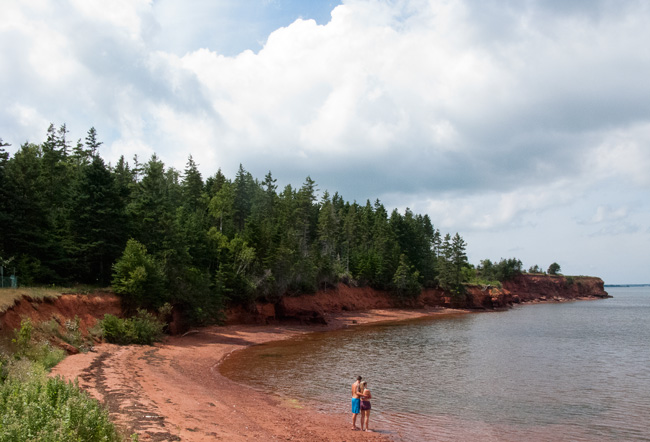
Our View - Rocky Point, Not Too Far From Charlottetown

Charlottetown and the Cruise Ship Van Damm
After a break at Rocky Point, the south eastern point on our route, we continued west to Victoria-by-the Sea, sounding just like an English seaside resort, but more of a historic seaport. Well it was named after Queen Victoria and turned out to be a charming little village with a small harbor.
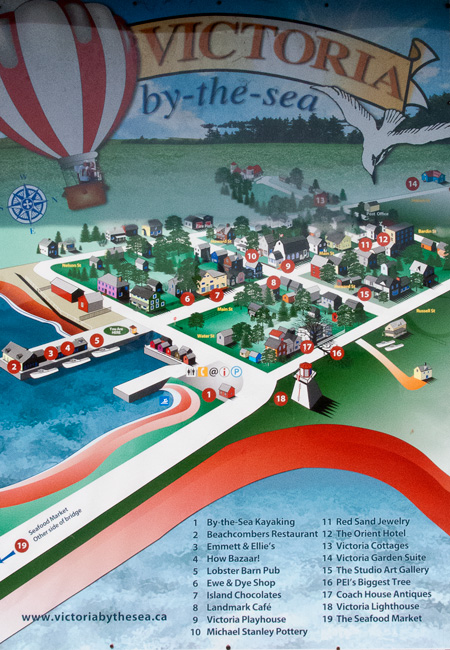
Map of Victoria - Pop. 77 (in 2006)
It clearly has built a good tourist business with three restaurants, a great coffee shop/chocolatier and bakery, a summer theater, galleries and craft shops, the inevitable touristy souvenir-type shops and a small beach. We stopped for coffee and who should show up but Jan, Bob, Barb, and Lee. We also ran into them at the Preserve Factory.( Think they must have a tracker on our car).
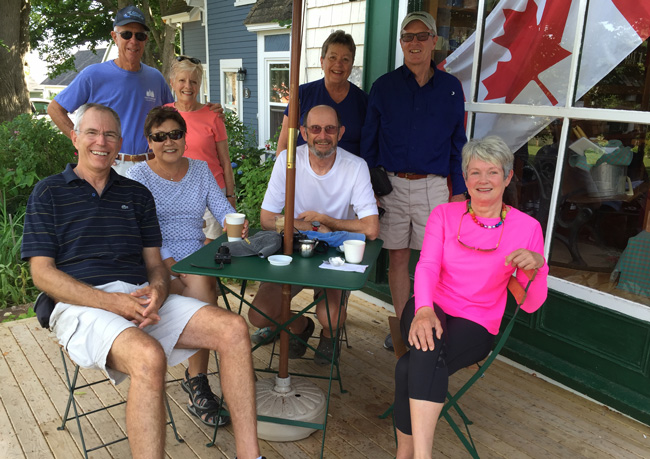
Being in Victoria was a lucky break as we have to stay another day in Summerside while the group moves on to Charlottetown tomorrow - or find another place to go and this looks like it. We found the harbor master, Vince, who lived by the wharf and chatted with him for quite a while. He has lived in Victoria all his life, was born three houses away and has lived in his current house for over 50 years. Have a spot on the dock for $20 a night with 15A electricity and water (and a shower?). Have our spot for tomorrow and theater tickets so we are all set. Vince said to come early and I can help him trim his hedges and put up a sailboat mast!
Our adventure for the day was soon over with just a quick ride back to Summerside and grocery shopping before dropping the car off on time. Renting a car has been a great way to go again as we would have been very limited in what we could see of PEI.
Thursday, July 28

Summerside, PEI to Victoria-by-the-Sea, PEI - 26 nm
We said goodbye to the rest of the gang as they took off for Charlottetown while we waited for the right time in the tide cycle to leave so we didn't arrive in the buoyed channel with minimum depth or "we might bump a bit" as one local said. "No problem, its only sand." Not wanting to chance that, we took our time on a calm, sunny day to pass under the Confederation Bridge not far from Summerside.
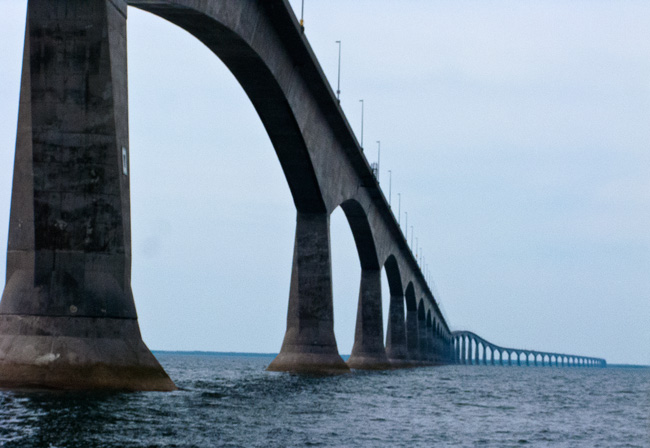
The Confederation Bridge joins the eastern Canadian provinces of Prince Edward Island and New Brunswick, making travel throughout the Maritimes easy and convenient. The curved, 8 mile long bridge is the longest in the world crossing ice-covered water, and more than a decade after its construction, it endures as one of Canada’s top engineering achievements of the 20th century. About 140' high for most of its length, it rises to almost 200' at its highest span to allow clearance for all ocean going boats. It was completed in 1977 at a cost of one billion dollars and replaced the ferry system. One way travel for a passenger car is $46.
We didn't "bump" going in and, with an advance phone call, Vince was waiting at the west dock for us and took our lines. This was our first tie up on a fixed dock with tides so we got to use our long dock lines from bow back past the stern and from the stern well forward of the bow allowing the boat to move better with the tide.
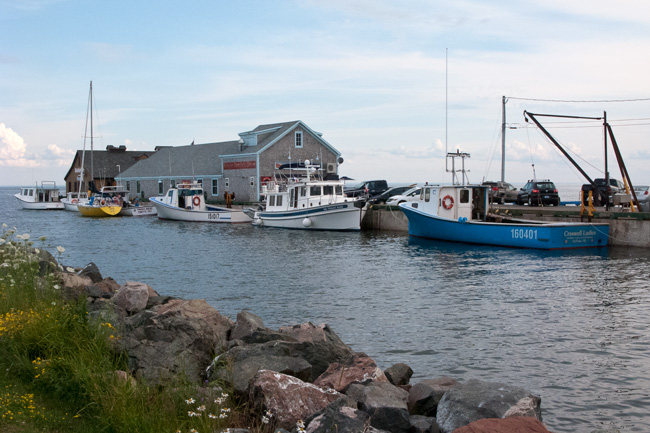
Luckily it was early afternoon and Vince had already done his hedge and the mast so we were free to wander around the small village. As you saw from the previous day's map Victoria is only four city blocks square. Sir Tugley attracted a lot of attention as usual and I spent quite a bit of time talking to people on the dock about the boat and the trip we are on.
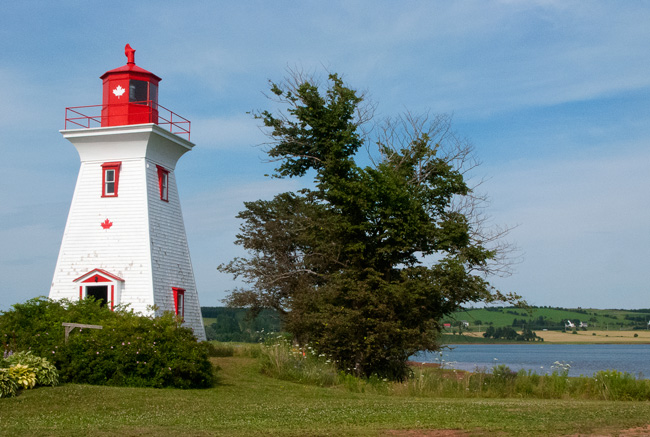
Victoria Lighthouse
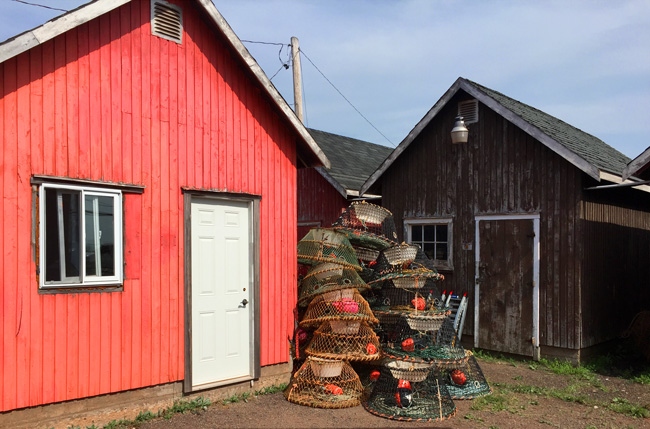
Done for The Season
Victoria was founded in 1819 by James Bardin Palmer, an immigrant lawyer and agent for the Earl of Westmoreland. His son Donald, following a well-conceived plan, laid out the village on Palmer’s estate. The effect can still be seen today by the grid pattern of its streets.
By the late 1800s, the settlement was prosperous with three wharves and many thriving businesses. Because of its sheltered harbour and strategic location, Victoria became an important seaport with a significant amount of trade with Europe, the West Indies and other East Coast ports. A wide variety of produce, including potatoes and eggs, was shipped by schooner from Victoria until the early 1900s. In the days of the steamboats Victoria was a regular stop for the SS Harland, dropping off visitors from Charlottetown and places further afield, to spend a few days relaxing in the beautiful village by the sea.
To accommodate the increase in shipping commerce and traveling visitors, the community developed services to cater to them including hotels, a general store, various stores and, a bank, a rink, a fox farm, a blacksmith shop, and a farm equipment dealer.
The rink was home to the Victoria Union, one of the most successful hockey teams in the Maritimes. When the Trans-Canada Highway bypassed Victoria many businesses and facilities relocated to nearby Crapaud. Today, with a year-round population of under two hundred, there are a number of family-run businesses employing local people, just as there were in the prosperous years up to the 1950s.
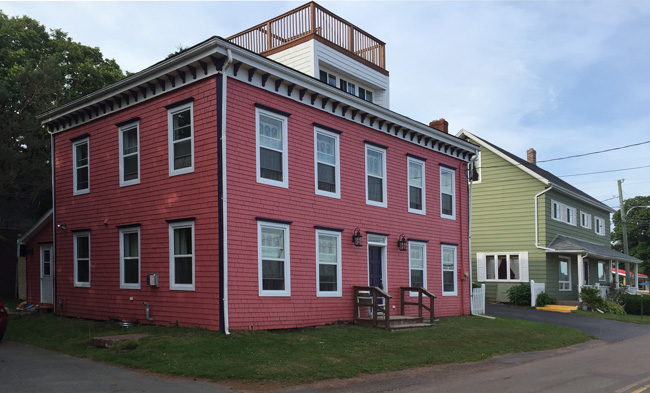
The Former Hotel and Vince's House Beyond
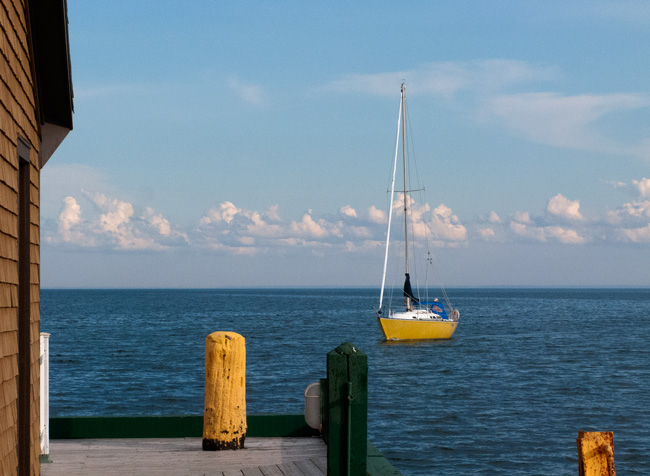
Chiquita Arriving, A Boat We Knew From Summerside
We splurged on dinner at the Landmark restaurant; Judy's seafood was good while my pie was a bit dry and over-seasoned, before heading across the street to the Victoria Playhouse for the evening's performance of the "Melville Brothers."

The play written by Norm Foster is a modern Canadian classic about a relaxing weekend trip full of fishing, football, and beer for the Melville brothers. So is confronting eldest brother Lee’s terminal illness. But their trip is thrown for a loop when the boys meet two attractive sisters who inadvertently change more than their weekend plans. The play is a comedy full of vigor about brotherhood and the unexpected. We thoroughly enjoyed it - excellent actors.
Friday, July 29
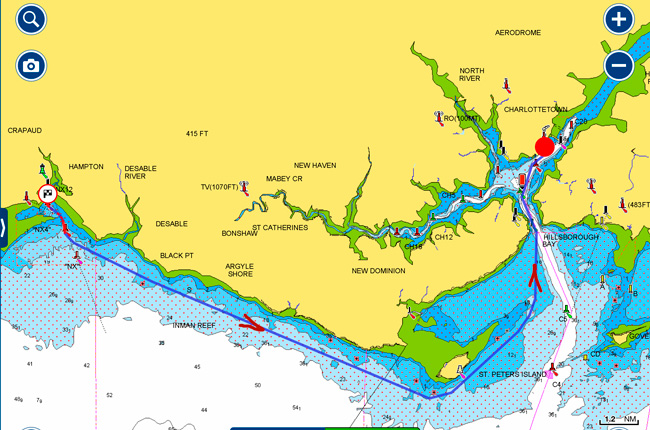
Victoria-by-the-Sea to Charlottetown, PEI - 25nm
Beautiful early morning, oily looking calm on the water as we threaded our way out of the long series of buoys. We timed it right and were on a high tide so no risk of a "bump" today. Once past the channel, it was only a couple of hours run to reach the large bay and Rocky Point where we were yesterday.
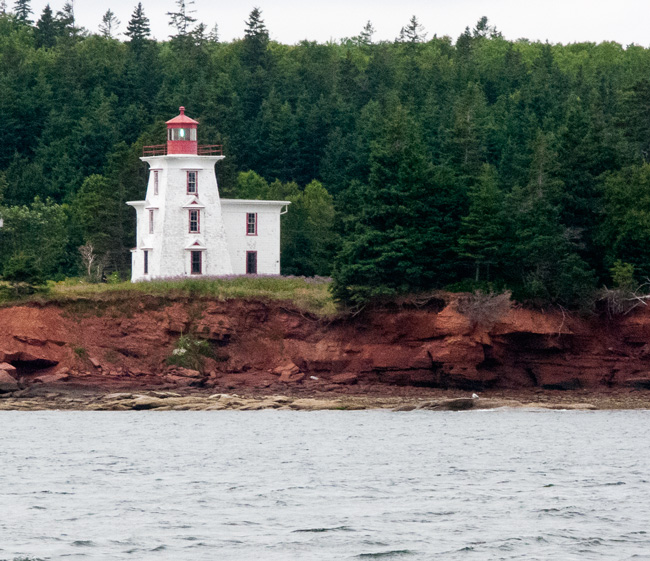
Rocky Point Lighthouse
We found a good slip assigned to us at Charlottetown Marina as far in as one could go, so we were well protected from any wave action; also right next to the restaurant, Steamers. There are three marinas, all close together here, but the new marina where we are gets the best reviews.
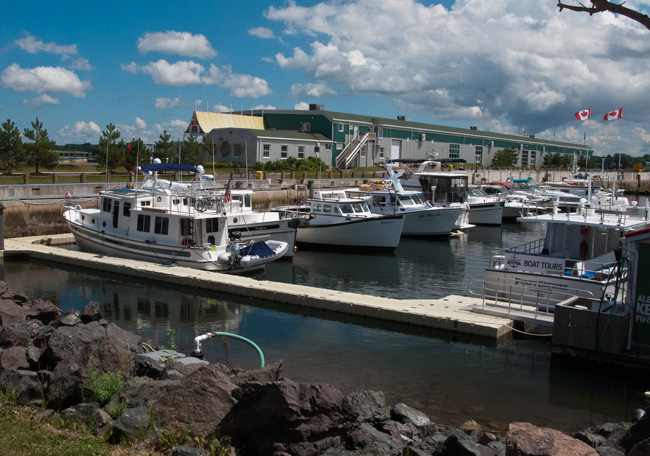
Both Stephen and Fran and Lee and Barb had friends in the area so they spent much of their time sightseeing with them while we did our own thing although we did get to join the crew of Wings at Steamers for a snack while they had lunch - very good fish and chips!
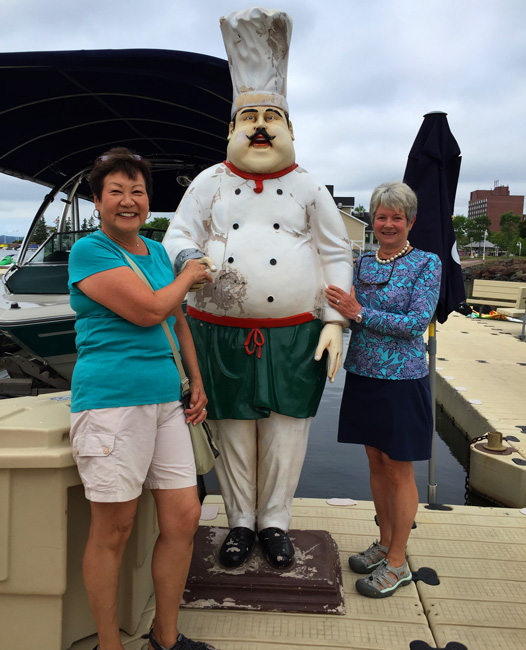
The Steamers Chef and Guess Who?
Most of the rest of the day was taken up with the normal jobs we have when we get into a marina, washing, boat cleaning etc. before we took a walk along the waterfront and checked out the gift shops and found some unique T-shirts for the grand kids, Dirt Shirts, dyed in genuine PEI red dirt. Better wash these by themselves! From there Judy gave the guided tour of much of the downtown as she had been exploring while the laundry was going. Found a good restaurant by the Art Center for a glass of wine while we sat and listened to a band playing nearby.
Saturday, July 30
Spent day in Charlottetown. Searched for a good bakery with the crew ....no success; a good baker could do well here. We walked another 2k out of town to the big indoor Farmers Market .... a happening place with several butchers, seafood stalls, many vegetable and fruit vendors and a bakers where we found some excellent bread and blueberry strudel. Caught the bus back into town and continued our walking tour to the Art Center where they were showing a Parks Canada movie about the big Confederation Meeting held in Charlottetown that paved the way for the joining of a number of provinces
Historically, Charlottetown's biggest claim to fame occurred in:
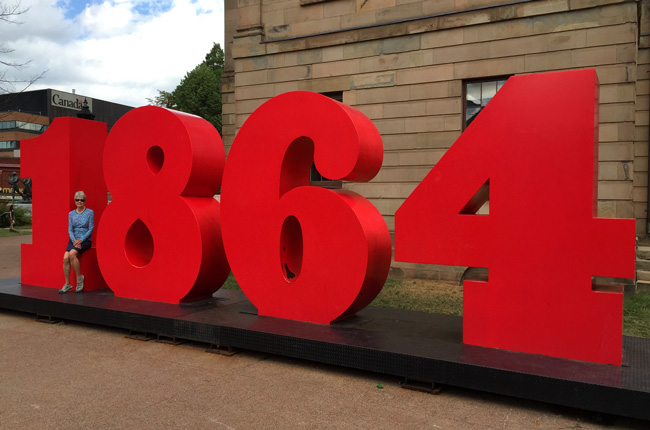
when the Charlottetown Conference of September 1864 set Confederation in motion. The meeting brought together delegates within Province House from New Brunswick, Nova Scotia and Prince Edward Island to discuss the union of their three provinces. The Charlottetown Conference was organized by the three Maritime colonies in reaction to failed attempts to persuade the Province of Canada to contribute to the construction of a railway from Halifax to Québec.
In 1862, the Province of Canada had refused to pay a portion of the costs for the Intercolonial Railway. That sparked discussions among the Maritime colonies about merging into a single unit in the hopes of gaining political strength and attracting overseas financial investment. Prince Edward Islanders welcomed any project that might buy out landlords who owned large swaths of island property, but lived outside the colony. Overall, however, support for Maritime union did not run deep.
The Province of Canada delegation was interested in creating a federal union with the Maritimes, mainly because of external threats. The creation of a huge United States army during the American Civil War, combined with Britain's desire to reduce its financial and military obligations to its colonies in North America, had boosted fears in Canada of American annexation. A string of weak and unstable colonial governments in the Province of Canada also added to pressures for a new political structure and demands for change. When Canadian political leaders learned of the upcoming conference in Charlottetown, they seized on the chance to attend, sending a delegation of heavyweight politicians which hadn't been invited by the Maritime organizers, but was welcomed anyway.
After extensive discussions of the next week, on 7 September, the Maritime delegates gave the Canadians their answer: they were unanimous in supporting a federation of all the provinces, provided the terms were satisfactory. The consensus extended beyond the general principle of Confederation. Several major issues were later regarded at the Québec Conference to have been unofficially agreed to at Charlottetown. The Intercolonial Railway was central to the deal. The Maritimers would accept Confederation if they got the railway; the Canadians would only build it as part of a political union. often failed in Canada.
Charlottetown was convened to discuss one project, Maritime Union, but its participants agreed to work towards the far grander scheme of Confederation which culminated in several more meetings, and ultimately in the The Constitution Act, 1867, originally known as the British North America Act, the law passed by the British Parliament creating the Dominion of Canada at Confederation. It provided for the union of three colonies — the Province of Canada (Ontario and Québec), Nova Scotia and New Brunswick — into a federal state with a parliamentary system modelled on that of Britain.
Ironically, Prince Edward Island, the site of the original discussions, did not join the Confederation at this time. The three colonies were followed by Rupert's Land acquired from the Hudson Bay Company in 1870 (almost one third of Canada's land mass), and six provinces were added to the original four: Manitoba (1870), British Columbia (1871), Prince Edward Island (1873), Alberta and Saskatchewan (1905), and Newfoundland (1949).
This ends today's history lesson!
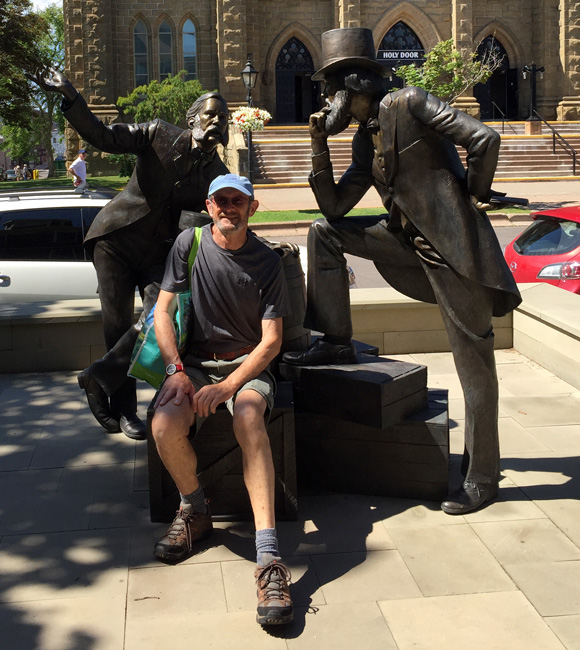
Joining the Political Discussion
At Confederation Hall, the Choral Group was singing "Oh, Canada". Throughout our time in Charlottetown, characters in period costume were wandering through the streets engaging passersby
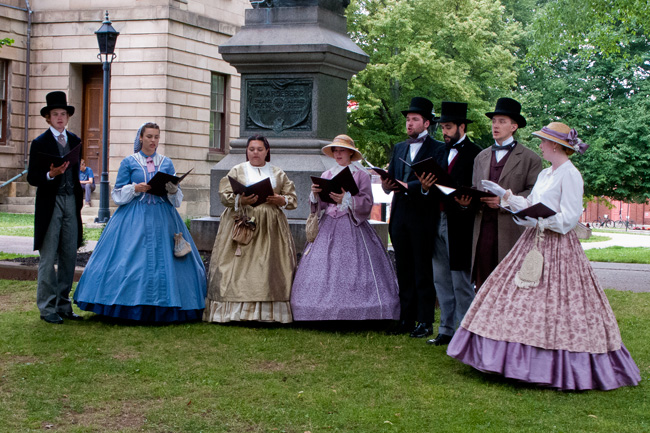
in conversation about the history of Charlottetown and a variety of topics; a good idea.
Charlottetown has much architectural history and a number of the older buildings have been carefully preserved with their original bright colors.
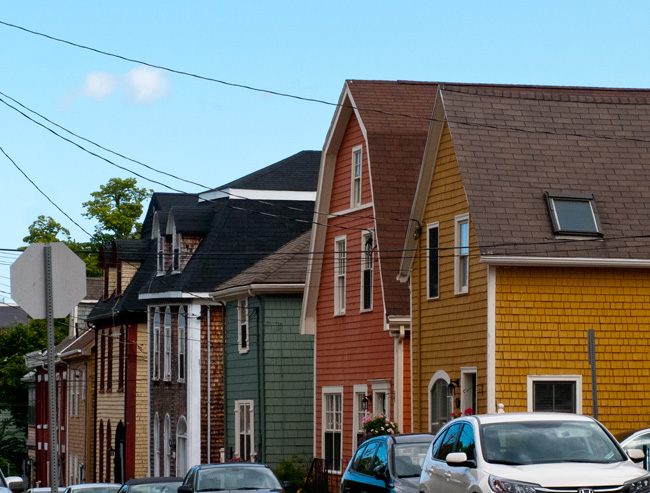
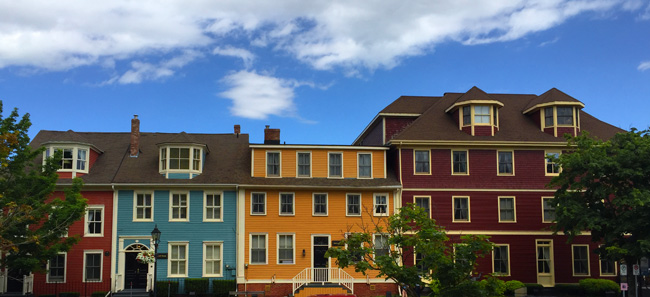
Charlottonians (?) are very proud of their gardens and the displays of hydrangeas and hostas were spectacular!

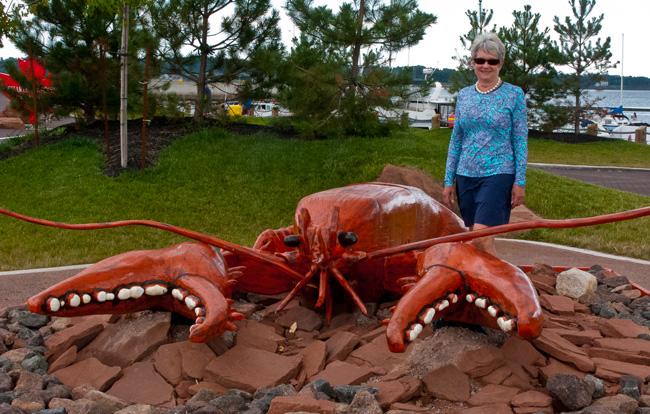
A Very Cheesy Tourist Photo!
Tonight we had one of our best meals for a while... home barbecued hamburger and fries (from Steamers). We topped the day off with ice cream from Cows, rated Number 1 in the World (sorry Nichole but Moomers didn't make the top ten).
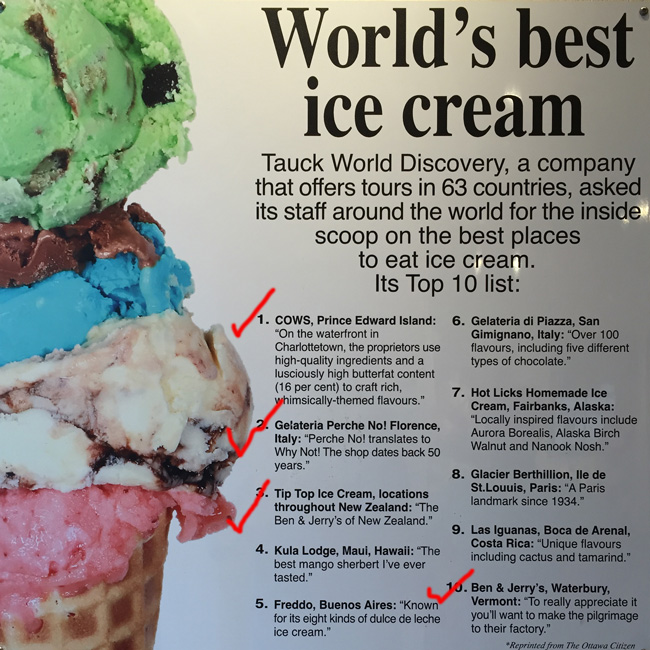
We both agreed that it deserved the title. We have now sampled the top three according to this list and will have to add some of the others as we travel. It would make a good bucket list item!
Sunday, July 31
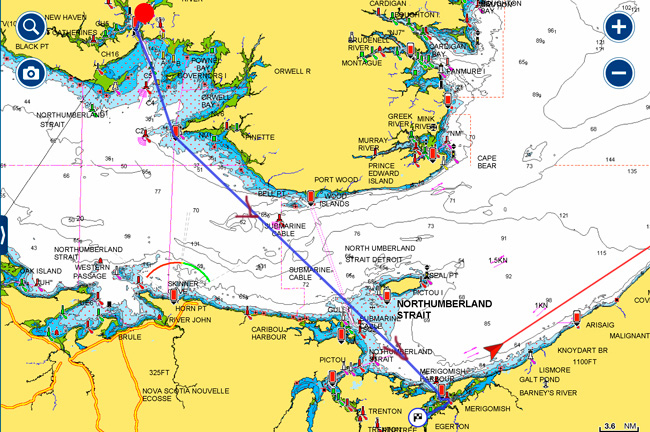
Charlottetown, PEI to Merigomish, Nova Scotia - 52nm
Bob flew out very early this morning to Lansing to visit his daughter who has terminal MS while Jan remained on the boat. He hopes to travel back on Tuesday and then catch up with us as we slowly move ahead over the next few days.
The three boats, Encore, Wings and STB set out for a long ride across the open water of the Northumberland Strait with not much of interest today other than clear skies and good water. We did spy one mega yacht as we were leaving Charlottetown - Reef Chief, a boat we were to run into several times later.
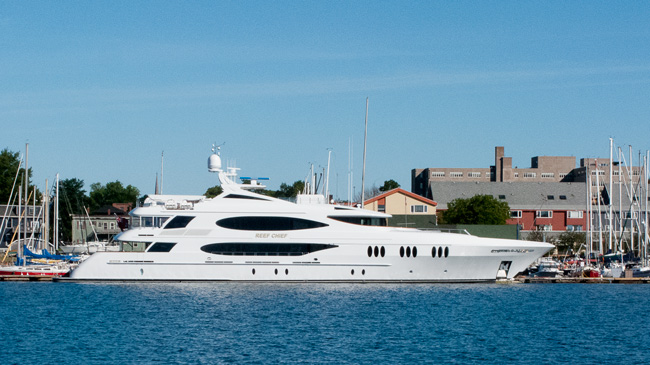
Reef Chief - 122 Ft. and It's For Sale at $3.5 Million
We eventually found the entry into Merigomish and then navigated four nm inland to Blackhall Gut, a narrow dead end channel with excellent protection. There were a few houses located here and boats from several came out to welcome us and talk about our trip. Very hospitable people here.
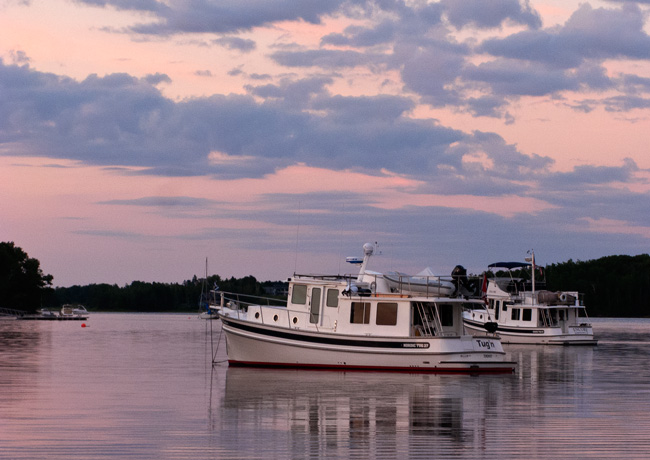
Tug'n and Encore in the Fading Light
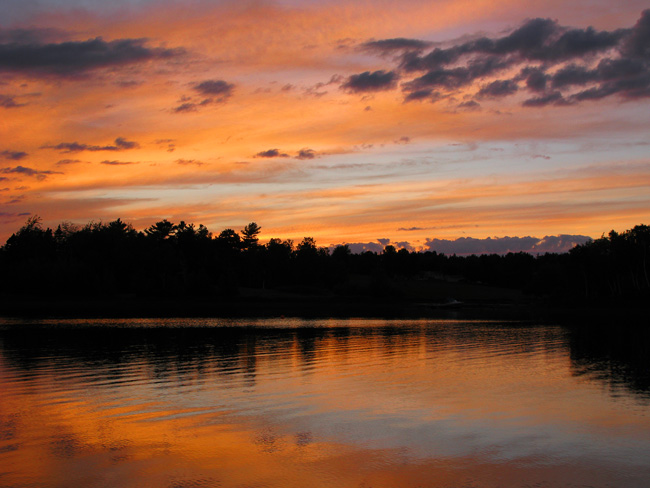
End of The Day!!
May 16 - 22 |
May 23 - 29 |
May 30 - Jun 5 |
Jun 6 - 12 |
Jun 13 - 19 |
Jun 20 - 26 |
Jun 27 - Jul 3 |
Jul 4 - 10 |
Jul 11 -17 |
Jul 18 - 24 |
Jul 25 - 31 |
Aug 1 - 7 |
Aug 8 - 14 |
Aug 15 -21 |
Aug 22 - 28 |
Aug 29 - Sep 4 |
Sep 5 - 11 |
Sep 12 - 18 |
Sep 19 - 25 |
